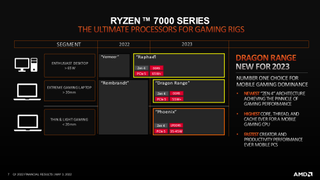
AMD has released an updated roadmap detailing the chipmaker's Zen 4 plans. Dragon Range and Phoenix are mobile Zen 4 APUs that will replace AMD's existing Ryzen 6000 (Rembrandt) product line. Dragon Range will power enthusiast gaming laptops, whereas Phoenix targets thin and light gaming devices. Surprisingly, AMD didn't specify what process node or the type of graphics that Dragon Range and Phoenix could be using. For reference, Rembrandt is on TSMC's 6nm manufacturing process and wields RDNA 2 graphics.
According to the AMD, Dragon Range will feature the "highest core, thread, and cache ever for a mobile gaming CPU." Although AMD didn't specify just how many Zen 4 cores, rumor has it that Dragon Range could potentially sport up to 16 cores, which would be insane for a gaming or workstation laptop.
Feature-wise, Dragon Range and Phoenix arrive with PCIe 5.0 support. The former, however, leverage DDR5 memory while the latter is on LPDDR5 memory. Ex-AnandTech editor Ian Cutress has confirmed with AMD that the Zen 4 chips' "exact mem support may include other technologies to be announced later." Furthermore, since the APUs compete in different segments, they adhere to specific thermal limits. Dragon Range, for example, features a TDP of 55W and higher, whereas Phoenix plays within the 35W to 45W range.
AMD has already given the hardware world a small teaser of Ryzen 7000 (Raphael), so we already know the processors will arrive before the end of the year to replace the Ryzen 5000 (Vermeer) stack. Like its other Zen 4 brethren, Raphael boasts support for PCIe 5.0 and DDR5 while debuting with a 65W+ TDP.
Raphael will hit the shelves in the second half of the year, and if AMD's illustration is accurate, we may be looking at a late launch in September. In a nutshell, Raphael brings Zen 4 to the mainstream market, commanding TSMC's 5nm process node and a new AM5 platform. Unfortunately, the AM5 platform may be costly for consumers as we've confirmed with multiple sources that Raphael only supports DDR5 memory, which currently carries a hefty premium.
Stay on the Cutting Edge
Join the experts who read Tom's Hardware for the inside track on enthusiast PC tech news — and have for over 25 years. We'll send breaking news and in-depth reviews of CPUs, GPUs, AI, maker hardware and more straight to your inbox.

Zhiye Liu is a Freelance News Writer at Tom’s Hardware US. Although he loves everything that’s hardware, he has a soft spot for CPUs, GPUs, and RAM.
-
hotaru251 is pcie5.0 even worth it for laptops?Reply
seems like would just cause thermal & power usage that isnt really benefiting much -
Samipini Reply
Well if you reduce the number of lanes needed to connected peripherals, that would also the power requirements. Also you can turn them back to gen 4 if needed. That means even better efficiency as gen 5 capable components are running less demanding standards.hotaru251 said:is pcie5.0 even worth it for laptops?
seems like would just cause thermal & power usage that isnt really benefiting much -
Now there's something to look up for. I hope desktop APU's will arrive at the same time. In 2023 DDR5 prices should decrease and I'm buying B600 mainboard anyway. If AM5 will have same longevity as AM4 it's not much of a cost to buy a mainboard once a few years.Reply
-
-Fran- It is really nice to see they're now finally catching up to their main uArch on both GPU and CPU for the APUs. I also hope they find a way to not make them monolithic anymore, at least for the non-ULV ones.Reply
A long time coming, but definitely cool.
Regards. -
Reply
I didn't know he left AnandTech. Now I know why he didn't publish any articles for some time. Too bad, I really did like his storage reviews. Those were one of the best I read on the internet.Integr8d said:Dr. Ian Cutress
Most Popular


